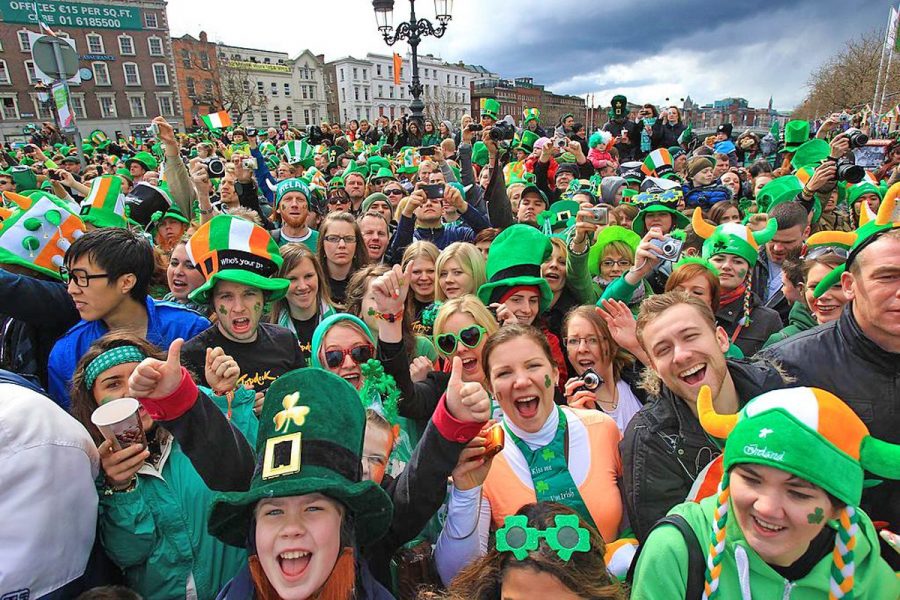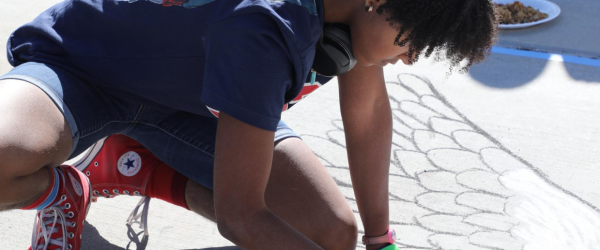The History of St. Patrick’s Day
People gathering together to celebrate St. Patrick’s Day.
March 22, 2021
St. Patrick’s Day is known to be a holiday where people wear green to avoid being pinched, stories of leprechauns protecting their pots of gold, and the infamous lucky clovers. However, the traditionally religious origins of the holiday dramatically differ from what people celebrate today.
The holiday is celebrated on March 17, the death anniversary of St. Patrick. St. Patrick lived during the 5th century and was born in Roman Britain. When he was only sixteen years old, he was kidnapped and brought to Ireland as a slave. He eventually escaped but returned to Ireland and was said to bring Christianity to the Irish people (History).
St. Patrick died on March 17, 461, but his legacy lives on. He is known to be a patron saint and national apostle of Ireland. Also, numerous legends were told about his life, such as a story that he explained the Holy Trinity using the three leaves of a shamrock, the native Irish clove.
Around the ninth and tenth centuries, the holiday began to become popular with people celebrating the day. The first St. Patrick’s Day parade did not take place in Ireland, but in America on March 17, 1601, in St. Augustine, Florida (History).
Due to the Potato Famine in 1845, there was a shortage of food in Ireland. Therefore, swarms of Irish people immigrated to America to start a new life. Unfortunately, the Irish were discriminated against when they entered. When they celebrated St. Patrick’s Day, newspapers portrayed them to be savages, showing them in cartoons of violent monkeys and drunkards.
Now, North America has the largest St. Patrick’s Day celebrations, but this holiday has spread worldwide, including places like Japan, Singapore, and Russia. In the United States, people celebrate the holiday wearing green, and in Chicago, the Chicago River would be dyed bright green. New York holds an annual St. Patrick’s Day parade, which is the world’s largest parade. The parade goes down Fifth Avenue and includes numerous floats and performances, which attracts a significant crowd (Hostel World).
Regarding the folktales of leprechauns, it was a belief that leprechauns came from the Celtic legends of fairies that used their power for good and evil, and these Celtic folktales had leprechauns known for trickery (History). Sarah Huynh (10) enjoys celebrating St. Patrick’s Day and “remembers back in kindergarten for Saint Patrick’s Day [she] would make leprechaun traps out of shoeboxes for arts and craft. After recess [she] remembered coming into the classroom. It was trashed and covered with gold coins. It was fun seeing everyone’s reaction to this as a little kid.” Even though St. Patrick’s Day’s celebration has become increasingly secular over the centuries, the holiday continues to be a fun day for those to get together and celebrate.























Fiona Salisbury • Apr 15, 2021 at 8:32 PM
This was a really interesting article. I didn’t know most of the history behind St. Patrick’s day, so I think that it is great that you were able to write about this topic. Great article!
Nikole galea • Apr 12, 2021 at 4:12 PM
Great article! My family and I don’t normally celebrate St. Patrick’s aside from wearing green. Although, after reading your article made me realize how cool the history of this holiday is and how important it is for others.
faith desio • Apr 11, 2021 at 1:40 PM
This is a very interesting article!! I have always loved St. Patrick’s Day because of the fun traditions and it is also my birthday. But I didn’t know all of the interesting history behind the holiday! Great article Anita!!
Katelyn Ruggles • Apr 10, 2021 at 10:27 PM
This article was super interesting. I knew St. Patrick’s Day was an Irish holiday but that is pretty much it so it was really cool to read up on the holiday and learn knew things about it.
Sharon Sun • Apr 10, 2021 at 5:18 PM
Great article Anita! I actually never knew that St. Patrick’s Day has a religious origin, and I always considered it more of having a fairy tale-like, whimsical backstory considering the mythical leprechauns.
Paige Reddick • Apr 9, 2021 at 1:05 PM
This is such a great article, Anita! I never knew the background of St. Patrick’s Day, and I’m so glad you shared this information with us all!
KAYDEN MANDLEY • Mar 31, 2021 at 11:40 AM
Even though I’m Irish I never knew the history behind St. Patrick’s Day. This was a great article, Anita!
Kylie de Best • Mar 30, 2021 at 4:04 PM
Wow! There is so much history to this holiday that I had never realized, and so I am glad you wrote this so that many can be more educated about this.